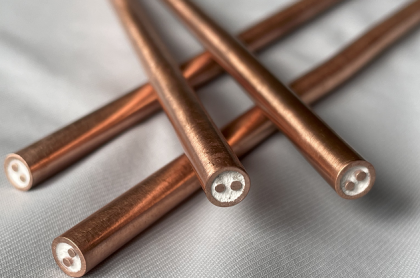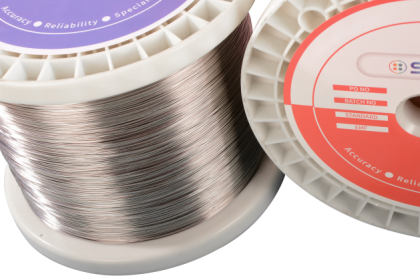With the rapid development of science and technology, the application range oftemperature sensors is becoming wider and wider, and they can be seen everywhere in daily life, which brings great convenience to people's life and industrial production. Temperature sensors organically combine semiconductor-related material and circuit properties to achieve the purpose of accurately measuring the ambient temperature. It can efficiently measure the temperature of various objects and prevent the phenomenon of short circuit of wires due to overheating of electrical appliances.
1. Sensor
1.1. Definition & Purpose
A temperature sensor is defined as a sensor that senses the temperature of an object or environment and converts it into usable output information. Usually, temperature sensors are made to combine the resistance value of the NTC with the change in temperature and output signals, effectively and successfully converting physical quantities into electrical quantities, so as to accurately measure the temperature as a device. Temperature sensors can measure and control the temperature of certain objects, but also to determine the wind speed, flow rate, measurement of temperature, microwave power and ultraviolet, infrared light, not only that, temperature sensors are also used in the same time in refrigerators, TVs, water heaters, air conditioners, computer monitors, equipment in the kitchen, automobiles and many other areas. Nowadays, temperature sensors are used in a wide range of products to prevent short circuits in electrical wiring. This is the reason why temperature sensors are so important to us.
1.2. Classification
At present, the commonly used temperature sensors are platinum resistance temperature sensors, PN junction temperature sensors, integrated temperature sensors, etc. According to the needs of the sensor and the environment to choose different temperature sensors.
Platinum resistance temperature sensors are common sensors whose function derives from the nature of the platinum resistance. A metal conductor will fluctuate in resistance as a result of temperature changes. The principle of platinum resistance temperature sensor is to detect the ambient temperature by detecting the change of platinum resistance.
If a metal conductor is used to prepare the temperature sensor, it is required to have high resistivity, low heat capacity and fast reaction speed. This type of metal such as iron, nickel, platinum, copper, etc.. However, due to the poor stability of iron and nickel, it is difficult to purify, copper and platinum have better performance. The properties of platinum are more suitable for the environment faced by temperature sensors. Therefore, platinum resistors are very common for the preparation of temperature sensors.
In 0°C ~ 630.74°C mapping relationship is RT=R0 (1 + AT + BT2), in -200°C ~ 0°C mapping relationship is RT=R0 (1+ AT + BT2 + CT3).
The principle of the PN junction temperature sensor is derived from the fact that the junction voltage of the PN junction of the transistor can show an approximately linear change characteristic with the measured ambient temperature, so the temperature sensor prepared by using the transistor can complete the temperature measurement. In a given current mode, there is a good linear relationship between the forward voltage of the PN junction and the ambient temperature.
The integrated temperature sensor isa sensor that integrates auxiliary circuits and temperature-sensitive transistors. This temperature sensor is similar to an integrated circuit, with relatively stable performance and an ideal linear relationship.
2. Design goals
2.1. design structure
The temperature sensor is a temperature sensing element, and its signal output is completed by processing the data by the single-chip microcomputer, and the temperature value is displayed through the digital tube. The provided temperature must be displayed through an external 5~12 V DC power supply, the range is controlled within -55°C~125°C, the accuracy must reach 1°C, and the digital tube can display the integer temperature. The temperature sensor has sound and light alarm function. If the alarm temperature is set to 30°C, it will be in a normal working state when the temperature is within 30°C; on the contrary, once the temperature reaches 30°C, the diode will emit light andwewillhear a sound, it’s the alarm sound from the buzzer. If there is no need to control the temperature during work, it can be set in advance to increase the temperature of the alarm appropriately. If you need to control a small part of the temperature during work, you can use the lead wire to lead out the temperature sensor.
It can be seen from the design concept that the temperature measurement system will have four modules: acquisition system, display processing system, alarm system and temperature sensor. The measured temperature signal is sent to the microprocessor through the transmission line, converted into a digital signal and sent to the calculator for comprehensive analysis and processing.
2.2. Production requirements
During the production process, there are 3 issues that need attention.
(1) Pay attention to whether the "°C" Celsius symbol is reversed. During the welding process, pay special attention to the digital tube of the Celsius symbol to be placed upside down to prevent the phenomenon of reverse direction;
(2) It is best to install it on the board, so that not only the space is saved, but also the heat dissipation effect is very good. Under normal temperature conditions, the temperature of the voltage stabilizing block will generally remain normal;
(3) Capacitors, triodes, and light-emitting diodes must not be reversed. If the connection is reversed, its function cannot be displayed. At the same time, the solder should not be too much during the welding process to avoid the occurrence of short circuits.
2.3. Installation &commissioning
Before debugging, be sure to check the circuit again to ensure that the welding is accurate and whether there is a short circuit on each pin. At the same time, when debugging, ensure that the circuit board is working at room temperature to ensure that all the work is accurate before connecting the power supply.
3. Circuit working principle and introduction
3.1. WorkingPrinciple
R1 is a temperature-sensitive resistance component. When the temperature changes, the resistance value of R1 will be changed. In principle, the constant current source built by the three-terminal voltage regulator LM317 will output a voltage signal that changes with the temperature for R1 excitation, and then through the precision The instrument amplifier INA114 amplifies the detection voltage signal to the standard voltage value Uo. The back-end acquisition equipment converts Uo into digital signals, and the digital signals will be recorded in the database in the form of data and converted into various displays.

At present, from the perspective of application, mainstream temperature sensors are divided into non-contact and contact temperature sensors, and can be divided into thermal resistance and thermocouple according to the material division.
3.2. ContactTemperatureSensor
The detection end of the contact temperature sensor should be in direct contact with the object to be detected. It is also called a thermometer. The thermometer follows the heat balance formed by convection and conduction. With strong accuracy and timeliness, it can quickly measure the temperature of the measured object, especially in the local temperature measurement, showing the temperature distribution. However, for objects with low heat capacity, detection errors are prone to occur. In terms of materials and principles used comprehensively, thermometers can be divided into liquid type, pressure type, and metal type, which are widely used in commercial, industrial and agricultural fields. In people's daily life, thermometeris also used to measure their own temperature.
3.3. Non-contactTemperatureSensor
The non-contact temperature sensor is completely opposite to the contact temperature sensor, it has no direct contact with the detected object. Its advantage is that it can be used to measure objects with small heat capacity and moving objects, and even objects whose temperature changes very fast can quickly display its surface temperature. Since the temperature measuring element of the non-contact temperature sensor does not touch the object to be measured, it can also be used for temperature measurement of public infrastructure such as public transportation. Its characteristic is that it can measure small targets in a moving state or objects with rapid or small heat capacity changes, and can measure the temperature field distribution, but it will be greatly affected by the ambient temperature. In actual use, a stable environment is required to ensure measurement accuracy. The non-contact temperature sensor has high detection efficiency and is less affected by environmental factors. It can realize accurate measurement in a small space. This method has strong applicability.
3.4. ThermocoupleSensor
The advantage of the thermocouple temperature sensor is that its structure is relatively simple. It is widely used by welding semiconductors or conductors of different materials. The two conductors form a closed loop, and an electromotive force is generated in the loop. Observing the thermal electromotive force can analyze the temperature of the object. Therefore, in order to ensure the accuracy of measurement results, the preparation of thermocouple temperature sensors requires strict requirements on hot spots and materials, and needs to have chemical and physical properties with high stability. Its temperature coefficient of resistance should be small, and its conductivity should be high. There is an obvious linear relationship between electromotive force and thermal electromotive force and temperature, ensuring reproducibility.
3.5. ThermalResistanceSensor
Thermocouple sensors measure temperature through thermal electromotive force and limit the range of temperature measurement. For objects from -200°C to 500°C, thermal resistance degrees Celsius can be applied. Its working principle is to measure temperature through the linear relationship between the resistance value of a semiconductor or conductor and the temperature change. Generally, the resistance value of common metal materials will increase by 0.4%~0.6%whenevery time the temperature rises by 1°C. This linear relationship can complete the measurement of the ambient temperature. The thermal resistance sensor detects the change of the surrounding temperature by the specific change of the resistance value of the thermistor, and the actual temperature of the measured object can be calculated according to the measured resistance value. The thermal resistance sensor can detect the lowest temperature and the highest temperature range is usually -200°C ~ 500°C.
The parts used in the sensor are mainly metal, and the following principles need to be met in terms of material selection:
(1) The resistance value of the resistive material and the temperature of the object should maintain a harmonious linear relationship and maintain long-term stability;
(2) The resistive material The higher the resistivity, the smaller the heat capacity of its metal fittings, and the faster the temperature detection response;
(3) The material is cost-effective, and the price is also very reasonable;
(4) Select the material according to the temperature range to be measured to ensure more stable physical properties .
4. Test Methods
The performance detection method of the temperature sensor should be analyzed based on the actual application scenarios of the sensor. For example, the sensor that detects the temperature of the engine coolant cannot be tested with an open flame during the performance test, otherwise the sensor will be seriously damaged. No matter which part is to be removed when the sensor is detected, the power must be cut off first, otherwise the removal of the part may cause excessive current or voltage rise inside the sensor, thus damaging the sensor.
The temperature sensor prepared by the platinum resistor needs to test the thermal response time of the platinum resistor first.Put the platinum resistor with the initial temperature into a constant temperature bath, calculate the time for the initial temperature to reach 63.2% of the difference between the medium temperature, and recordas time constant. Set a sampling time of 10s, test every second, and record the time constant.
R-T characteristic test is required when testing the thermal performance of NTC negative temperature coefficient thermistor. Due to a certain temperature range, the resistance value of the NTC thermistor will show a non-linear downward trend as the temperature rises, that is, in the process of temperature rise, its resistance value will show a gradual change trend. This cannot measure temperature accurately. For this kind of nonlinear relationship between temperature and resistance, it is necessary to study its parameters through a large number of experiments, and to obtain the mapping relationship between temperature and resistance by fitting the curve relationship by regression method.
The accuracy of the R-T curve of the NTC thermistor is directly related to the performance, so resistance measurement is an extremely important link. More typical methods such as DC bridge method and constant current method. The DC bridge method is to use 4 resistors, among which the measured resistors form a bridge, determine the resistance adjustment to balance the bridge, and collect and distribute the measured resistors through the principle of electrical voltage division. The constant current method is a control experiment method. Connect two resistors in series in a closed circuit, use a voltmeter to obtain real-time voltage data at both ends, and adjust the resistors in the comparison experiment so that the values of the voltmeter are the same, and the measured resistance is measured.
4.1. Detection of water temperature sensor
The temperature sensor needs to unplug the wire connector in the process of water temperature detection. If the water temperature is different, it needs to use the resistance meter to detect. During testing, it is necessary to ensure that the resistance value complies with the data shown in the table1 below. During the installation of the sensor, it is necessary to connect the wires in time to ensure that the ignition switch is in the ON state, the voltage value at both ends of THW and E2 should be 0.1~1.0V and the water temperature is at 80°C. If no voltage is displayed when measuring, further systematic inspection is required.
|
water temperature/°C
|
resistance/kΩ
|
|
0
|
4~7
|
|
20
|
2~3
|
|
40
|
0.9~1.3
|
|
60
|
0.4~0.7
|
|
80
|
0.2~0.4
|
Table 1
4.2. Detection of intake air temperature sensor
The detection method of the intake air temperature sensor is the same as that of the water temperature sensor, and it is necessary to cut off the power of the sensor in time during the inspection. Then, ensure that the ignition switch is in the ON state, and analyze whether there is voltage at the terminals of THW and E2. The voltage range is 0.5~3.4 V, and the water temperature should be at 20°C. If no voltage is displayed when measuring, further inspection is also required to find out the cause of the failure.
4.3. Detection of coolant temperature sensor and intake air temperature sensor
When testing, the sensor needs to be installed on the engine, and a voltmeter is prepared to be connected to the terminal of the sensor. According to the different temperatures of the coolant, the voltmeter will display. Occasionally, the internal resistance value will appear, which is only possible when the ECU is connected to the engine coolant temperature sensor and the temperature reaches 49 °C. The change of the resistance value will affect the pressure array between the two poles and also change.
During the use of the sensor, its computer system may experience some fluctuations, which are normal and only need to be controlled within the allowable range. At the same time, if the intake air temperature sensor is installed at the position of the engine, a voltmeter needs to be connected between the two terminals to display the temperature value. The numerical standard is often shown in Table 2. In the process of temperature sensor design and performance inspection, it is necessary to conduct detailed analysis in strict accordance with existing standards, and at the same time make adjustments in combination with different usage scenarios and usage requirements, so as to ensure that the temperature sensor can truly meet the actual detection needs.
|
temperature/°F
|
Voltage/V
|
temperature/°F
|
Voltage/V
|
|
-20
|
4.81
|
140
|
1.52
|
|
0
|
4.7
|
160
|
1.15
|
|
20
|
4.47
|
180
|
0.86
|
|
40
|
4.11
|
200
|
0.65
|
|
60
|
3.67
|
220
|
0.48
|
|
80
|
3.08
|
240
|
0.35
|
|
100
|
2.51
|
260
|
0.28
|
|
120
|
1.97
|
|
|
Table 2












 IPv6 network supported
IPv6 network supported